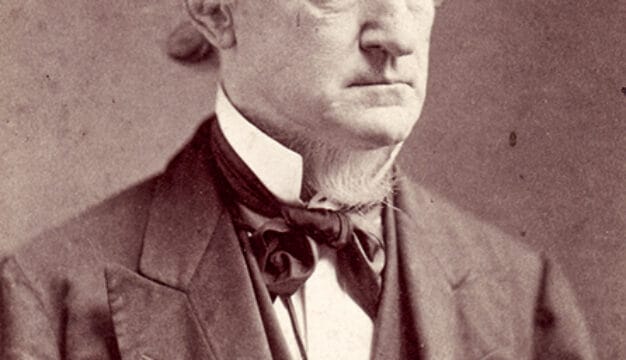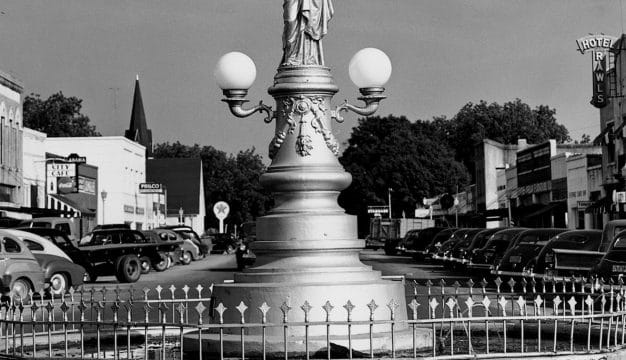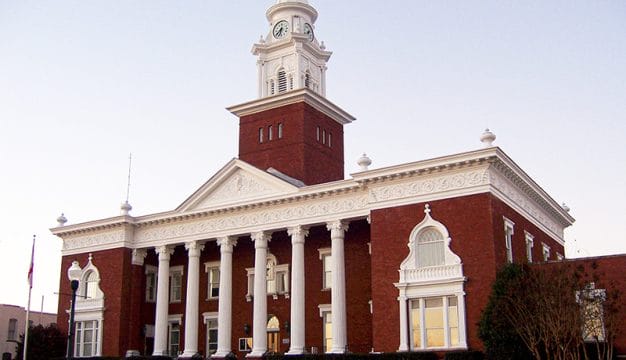Morgan County
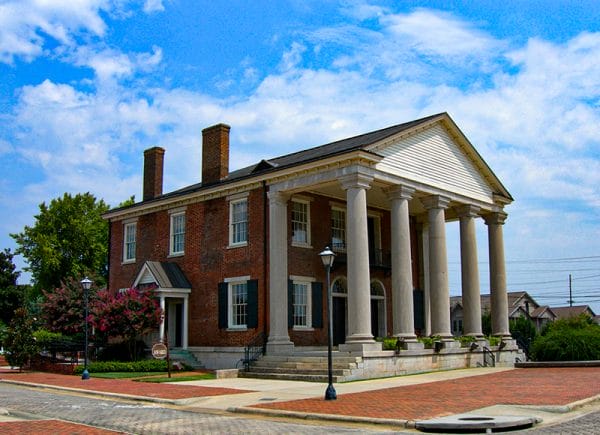 Old State Bank
Located in the north-central part of the state, Morgan County is home to numerous waterways. The second Scottsboro trial also took place in Morgan County on March 28, 1933, after a change of venue from Stevenson, Jackson County. The county is governed by an elected five-member commission and includes the incorporated communities of Hartselle, Trinity, Priceville, and Falkville.
Old State Bank
Located in the north-central part of the state, Morgan County is home to numerous waterways. The second Scottsboro trial also took place in Morgan County on March 28, 1933, after a change of venue from Stevenson, Jackson County. The county is governed by an elected five-member commission and includes the incorporated communities of Hartselle, Trinity, Priceville, and Falkville.
- Founding Date: February 6, 1818
- Area: 575 square miles
- Population: 123,421 (2020 Census estimate)
- Major Waterways: Tennessee River
- Major Highways: U.S. 31, U.S. 72, Interstate 65
- County Seat: Decatur
- Largest City: Decatur
History
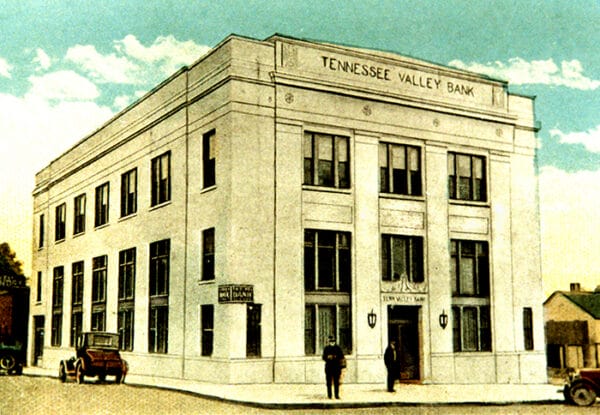 Morgan County Archives
Morgan County was created by an act of the Alabama Territorial General Assembly on February 6, 1818, preceding Alabama’s statehood by almost two years. The county was created from land acquired from the Cherokee Indians by the 1818 Treaty of Turkeytown. The county was originally named Cotaco for a creek that flows through it. When the area was officially opened in 1818, settlers came mostly from Tennessee, Georgia, Virginia, and the Carolinas. The first towns in present-day Morgan County grew up along the banks of the Cotaco and Flint creeks and their tributaries. Some of these early towns were Flint, Danville, Bluff City, Decatur, and Hartselle. On June 14, 1821, the name was changed to Morgan County in honor of Gen. Daniel Morgan of Virginia, who fought in the American Revolution. The county seat was at Somerville from 1818 until 1891, when it was moved to Decatur.
Morgan County Archives
Morgan County was created by an act of the Alabama Territorial General Assembly on February 6, 1818, preceding Alabama’s statehood by almost two years. The county was created from land acquired from the Cherokee Indians by the 1818 Treaty of Turkeytown. The county was originally named Cotaco for a creek that flows through it. When the area was officially opened in 1818, settlers came mostly from Tennessee, Georgia, Virginia, and the Carolinas. The first towns in present-day Morgan County grew up along the banks of the Cotaco and Flint creeks and their tributaries. Some of these early towns were Flint, Danville, Bluff City, Decatur, and Hartselle. On June 14, 1821, the name was changed to Morgan County in honor of Gen. Daniel Morgan of Virginia, who fought in the American Revolution. The county seat was at Somerville from 1818 until 1891, when it was moved to Decatur.
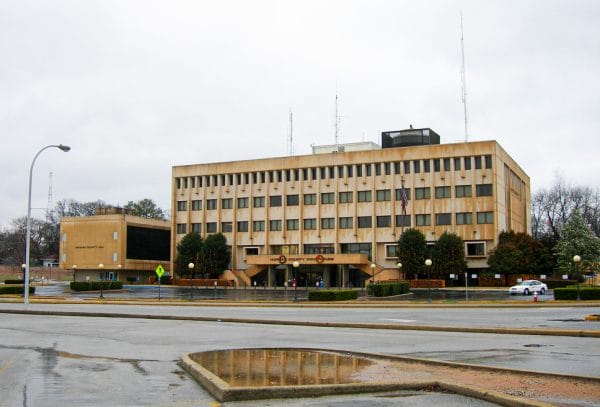 Morgan County Courthouse
During the Civil War, northern Morgan County was a hotly contested area because of its access to a railroad bridge across the Tennessee River. Decatur hosted headquarters of both United States and Confederate forces during the war. The city was the site of the Battle of Decatur in 1864, and all but three buildings in Decatur were torn down by occupying federal forces and reused in the construction of barracks and other military structures. Later, courthouse fires in 1926 and 1938 destroyed many records about the county’s early history.
Morgan County Courthouse
During the Civil War, northern Morgan County was a hotly contested area because of its access to a railroad bridge across the Tennessee River. Decatur hosted headquarters of both United States and Confederate forces during the war. The city was the site of the Battle of Decatur in 1864, and all but three buildings in Decatur were torn down by occupying federal forces and reused in the construction of barracks and other military structures. Later, courthouse fires in 1926 and 1938 destroyed many records about the county’s early history.
Major Cities and Demographics
According to 2020 Census estimates, the population of Morgan County was 123,421. Of that total, 82.4 percent of respondents identified themselves as white, 13.3 percent as African American, 9.0 percent as Hispanic, 2.4 percent as two or more races, 1.1 percent as Native American, 0.7 percent as Asian, and 0.2 percent as Hawaiian or Pacific Islander. The county seat Decatur is the largest city in the county with an estimated population of 54,344. Other significant population centers include Hartselle, Trinity, Priceville, and Falkville. The median household income was $52,923, compared with $52,035 for the state as a whole, and the per capita income was $28,474, compared with $28,934 for the state as a whole.
Economy
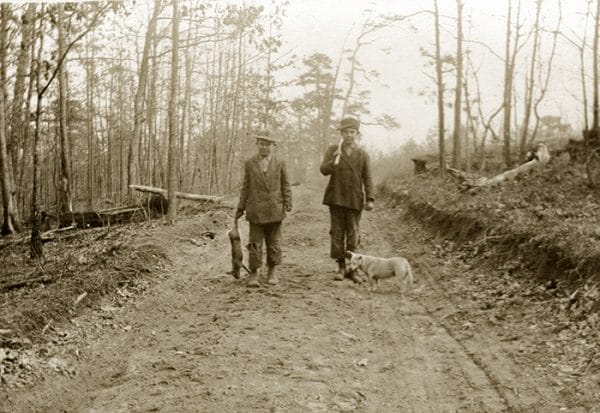 Successful Rabbit Hunt
The first settlers in what would become Morgan County were generally farmers. Some established large-scale cotton plantations on the fertile lands bordering the Tennessee River. Those who settled along the county’s abundant small creeks worked small farms. Abundant ferries and steamboat stops made early Morgan County a center for cotton shipping and the lumber industry. Cattle, hog, and sheep farming were minor economic efforts in the Cumberland Plateau region as well. During the 1930s, the Tennessee Valley Authority made the Tennessee River navigable with a series of locks and dams, which also provided abundant and inexpensive electricity. Morgan County’s economy thus shifted from agriculture and forestry to industry and manufacturing.
Successful Rabbit Hunt
The first settlers in what would become Morgan County were generally farmers. Some established large-scale cotton plantations on the fertile lands bordering the Tennessee River. Those who settled along the county’s abundant small creeks worked small farms. Abundant ferries and steamboat stops made early Morgan County a center for cotton shipping and the lumber industry. Cattle, hog, and sheep farming were minor economic efforts in the Cumberland Plateau region as well. During the 1930s, the Tennessee Valley Authority made the Tennessee River navigable with a series of locks and dams, which also provided abundant and inexpensive electricity. Morgan County’s economy thus shifted from agriculture and forestry to industry and manufacturing.
Employment
According to 2020 Census estimates, the workforce in Morgan County was divided among the following industrial categories:
- Manufacturing (21.5 percent)
- Educational services, and health care and social assistance (18.7 percent)
- Retail trade (11.6 percent)
- Professional, scientific, management, and administrative and waste management services (9.4 percent)
- Arts, entertainment, recreation, and accommodation and food services (9.2 percent)
- Construction (8.6 percent)
- Other services, except public administration (5.0 percent)
- Transportation and warehousing, and utilities (4.1 percent)
- Finance and insurance, and real estate, rental, and leasing (3.5 percent)
- Public administration (3.5 percent)
- Wholesale trade (2.4 percent)
- Agriculture, forestry, fishing and hunting, and extractive (1.3 percent)
- Information (1.2 percent)
Education
The Morgan County School System oversees 14 primary and secondary schools. In addition, the Decatur City Schools oversees 24 primary and secondary schools, and the Hartselle City Schools oversees eight primary and secondary schools. Calhoun Community College, located in Decatur, is Alabama’s largest two-year college, offering academic and technical education programs and degrees.
Geography
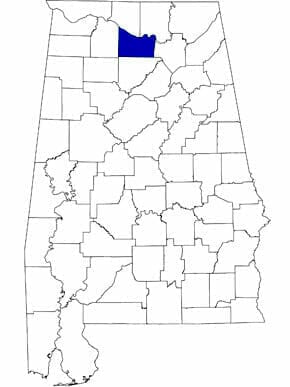 Morgan County Map
Comprising approximately 575 square miles, Morgan County is located in the north-central part of the state. The northern half of the county lies in the Highland Rim physiographic section, and the southern half lies in the Cumberland Plateau section. The county is bordered to the north by Limestone and Madison Counties, to the east by Marshall County, to the south by Cullman County, and to the west by Lawrence County.
Morgan County Map
Comprising approximately 575 square miles, Morgan County is located in the north-central part of the state. The northern half of the county lies in the Highland Rim physiographic section, and the southern half lies in the Cumberland Plateau section. The county is bordered to the north by Limestone and Madison Counties, to the east by Marshall County, to the south by Cullman County, and to the west by Lawrence County.
The Tennessee River runs along the northern boundary of Morgan County, with its many tributaries running throughout the county. The Tennessee River is the largest river system to pass through Alabama, and it is home to the rarest cavefish in America, the Alabama Cavefish. The river is considered one of the most biologically diverse river systems for aquatic organisms in the U.S., with over 176 species of fish, many of which are considered at-risk. The Wheeler Lake section of the Tennessee River drains virtually all of Morgan County and occupies approximately 67,000 acres.
U.S. Highway 31 runs north-south through Decatur and Hartselle, and U.S. 72 runs east-west from Memphis to Atlanta through Decatur. Interstate 65, part of the interstate system that connects the Gulf Coast to the Great Lakes, runs through Morgan County. Pryor Field in Decatur and Hartselle-Morgan County Regional Airport in Hartselle are the county’s two public airports.
Events and Places of Interest
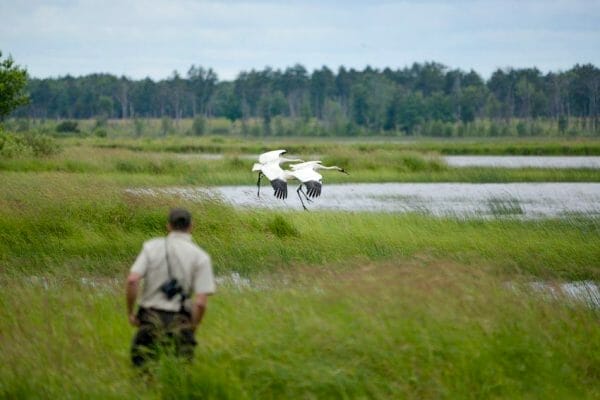 Wheeler National Wildlife Refuge
Morgan County offers a range of opportunities for recreational activities. Wheeler National Wildlife Refuge located between Decatur and Hartselle along the Tennessee River consists of 35,000 acres of wildlife habitat. The refuge is home to Alabama’s largest wintering duck population. Visitors can take part in a variety of recreational activities, including hunting, fishing, hiking, bird watching, camping, and educational programs. Point Mallard Municipal Park in Decatur covers 750 acres and features a 35-acre water-themed park, 210 campsites, a golf course, an amphitheater, and hiking and biking trails. The park also hosts special events such as the annual Civil War reenactment of the Battle of Decatur every September.
Wheeler National Wildlife Refuge
Morgan County offers a range of opportunities for recreational activities. Wheeler National Wildlife Refuge located between Decatur and Hartselle along the Tennessee River consists of 35,000 acres of wildlife habitat. The refuge is home to Alabama’s largest wintering duck population. Visitors can take part in a variety of recreational activities, including hunting, fishing, hiking, bird watching, camping, and educational programs. Point Mallard Municipal Park in Decatur covers 750 acres and features a 35-acre water-themed park, 210 campsites, a golf course, an amphitheater, and hiking and biking trails. The park also hosts special events such as the annual Civil War reenactment of the Battle of Decatur every September.
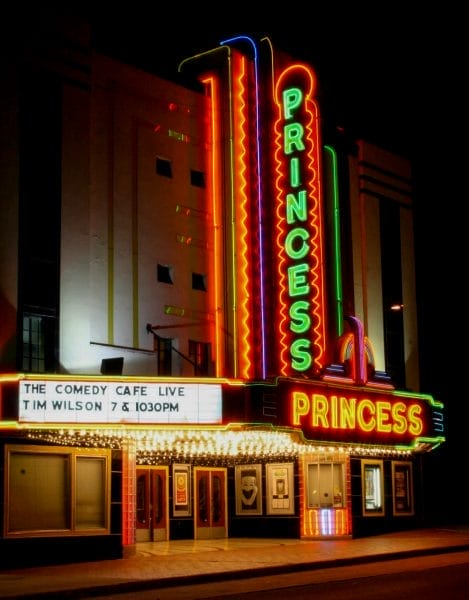 Princess Theatre in Decatur
Many of Decatur’s notable nineteenth- and twentieth-century homes and commercial buildings can be seen in the Albany Heritage Neighborhood Historic District and the Old Decatur Historic District, which includes several buildings listed on the National Register of Historic Places as well as the only three buildings left standing from the pre-Civil War era: the Dancy-Polk House (1829), the Old State Bank (1833), and the Rhea-McEntire House (1835). The Old State Bank is now a local history museum open to visitors, and the Decatur Union Depot Museum celebrates the region’s railroad history. Historical artifacts, documents, photographs, and other items are housed in the Morgan County Archives in Decatur. The Princess Theatre, built in 1887, originally served as a horse stable for a hotel among other purposes. It has been home to the Performing Arts Center since 1983.
Princess Theatre in Decatur
Many of Decatur’s notable nineteenth- and twentieth-century homes and commercial buildings can be seen in the Albany Heritage Neighborhood Historic District and the Old Decatur Historic District, which includes several buildings listed on the National Register of Historic Places as well as the only three buildings left standing from the pre-Civil War era: the Dancy-Polk House (1829), the Old State Bank (1833), and the Rhea-McEntire House (1835). The Old State Bank is now a local history museum open to visitors, and the Decatur Union Depot Museum celebrates the region’s railroad history. Historical artifacts, documents, photographs, and other items are housed in the Morgan County Archives in Decatur. The Princess Theatre, built in 1887, originally served as a horse stable for a hotel among other purposes. It has been home to the Performing Arts Center since 1983.
 Alabama Jubilee Hot Air Balloon Classic
The Carnegie Visual Arts Center in Decatur was built in 1904 as part of industrialist Andrew Carnegie’s public library project. The building served as the city library until 1973. In 2001, the building was restored to hold the city’s arts center and hosts local and touring exhibitions as well as art classes, workshops, and lectures. Also in Decatur, Cook’s Natural Science Museum houses extensive collections of wildlife specimens, especially those species native to the Tennessee Valley.
Alabama Jubilee Hot Air Balloon Classic
The Carnegie Visual Arts Center in Decatur was built in 1904 as part of industrialist Andrew Carnegie’s public library project. The building served as the city library until 1973. In 2001, the building was restored to hold the city’s arts center and hosts local and touring exhibitions as well as art classes, workshops, and lectures. Also in Decatur, Cook’s Natural Science Museum houses extensive collections of wildlife specimens, especially those species native to the Tennessee Valley.
Each year, Morgan County hosts a variety of festivals and celebrations. The Spirit of America 4th of July Festival is one of Alabama’s largest Independence Day celebrations. Each September, Hartselle celebrates the town’s railroad heritage at the Depot Days Festival. Calhoun Community College hosts the Southern Wildlife Festival in mid-October. The festival features a variety of arts and crafts related to wildlife and nature conservancy.
Further Reading
- The Heritage of Morgan County, Alabama. Clanton, Ala.: Heritage Publishing Consultants, 1998.
- Knox, John. History of Morgan County, Alabama. Decatur, Ala.: Decatur Printing Company, 1966.
External Links
- Morgan County
- Morgan County Schools
- City of Decatur
- City of Hartselle
- City of Priceville
- Town of Falkville
- Town of Somerville
- Town of Trinity
- Decatur-Morgan County Chamber of Commerce
- Decatur Public Library
- Calhoun Community College
- Morgan County Archives
- National Register of Historic Places: Morgan County
- Princess Theatre
- Cook's Museum of Natural Science
- Carnegie Visual Arts Center
- Old State Bank
- Historic Decatur Union Depot
- Point Mallard Park
- Wheeler National Wildlife Refuge
- Visit North Alabama
